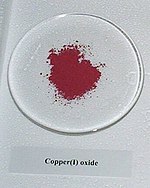Copper(I) oxide
 |
|
 |
|
 |
|
| Names | |
|---|---|
|
IUPAC name
Copper(I) oxide
|
|
| Other names | |
| Identifiers | |
|
1317-39-1 |
|
| 3D model (Jmol) |
Interactive image Interactive image |
| ChemSpider |
8488659 |
| ECHA InfoCard | 100.013.883 |
| EC Number | 215-270-7 |
| KEGG |
C18714 |
| PubChem | 10313194 |
| RTECS number | GL8050000 |
| UNII |
T8BEA5064F |
|
|
|
|
| Properties | |
| Cu2O | |
| Molar mass | 143.09 g/mol |
| Appearance | brownish-red solid |
| Density | 6.0 g/cm3 |
| Melting point | 1,232 °C (2,250 °F; 1,505 K) |
| Boiling point | 1,800 °C (3,270 °F; 2,070 K) |
| Insoluble | |
| Solubility in acid | Soluble |
| Band gap | 2.137 eV |
| -20·10−6 cm3/mol | |
| Structure | |
| cubic | |
| Thermochemistry | |
|
Std molar
entropy (S |
93 J·mol−1·K−1 |
|
Std enthalpy of
formation (ΔfH |
−170 kJ·mol−1 |
| Hazards | |
| Safety data sheet | SIRI.org |
|
EU classification (DSD)
|
Harmful (Xn) Dangerous for the environment (N) |
| R-phrases | R22, R50/53 |
| S-phrases | (S2), S22, S60, S61 |
| NFPA 704 | |
| US health exposure limits (NIOSH): | |
|
PEL (Permissible)
|
TWA 1 mg/m3 (as Cu) |
|
REL (Recommended)
|
TWA 1 mg/m3 (as Cu) |
|
IDLH (Immediate danger)
|
TWA 100 mg/m3 (as Cu) |
| Related compounds | |
|
Other anions
|
Copper(I) sulfide Copper(II) sulfide Copper(I) selenide |
|
Other cations
|
Copper(II) oxide Silver(I) oxide Nickel(II) oxide Zinc oxide |
|
Except where otherwise noted, data are given for materials in their standard state (at 25 °C [77 °F], 100 kPa).
|
|
|
|
|
| Infobox references | |
Copper(I) oxide or cuprous oxide is the inorganic compound with the formula Cu2O. It is one of the principal oxides of copper, the other being CuO or cupric oxide. This red-coloured solid is a component of some antifouling paints. The compound can appear either yellow or red, depending on the size of the particles. Copper(I) oxide is found as the reddish mineral cuprite.
Copper(I) oxide may be produced by several methods. Most straightforwardly, it arises via the oxidation of copper metal:
Additives such as water and acids affect the rate of this process as well as the further oxidation to copper(II) oxides. It is also produced commercially by reduction of copper(II) solutions with sulfur dioxide. Aqueous cuprous chloride solutions react with base to give the same material. In all cases, the color is highly sensitive to the procedural details.
Formation of copper(I) oxide is the basis of the Fehling's test and Benedict's test for reducing sugars. These sugars reduce an alkaline solution of a copper(II) salt, giving a bright red precipitate of Cu2O.
It forms on silver-plated copper parts exposed to moisture when the silver layer is porous or damaged. This kind of corrosion is known as red plague.
Little evidence exists for cuprous hydroxide, which is expected to rapidly undergo dehydration. A similar situation applies to the hydroxides of gold(I) and silver(I).
The solid is diamagnetic. In terms of their coordination spheres, copper centres are 2-coordinated and the oxides are tetrahedral. The structure thus resembles in some sense the main polymorphs of SiO2, and both structures feature interpenetrated lattices.
...
Wikipedia

